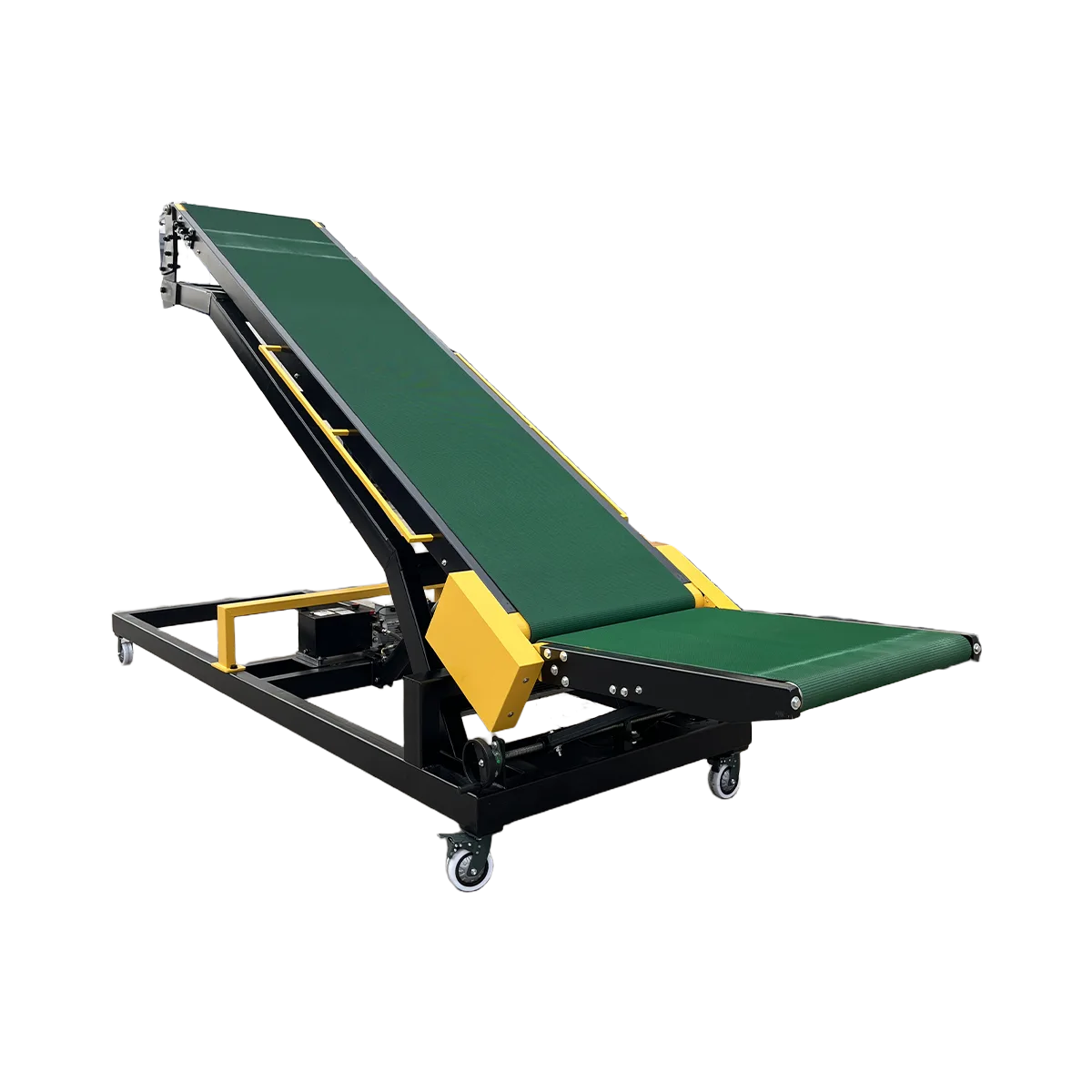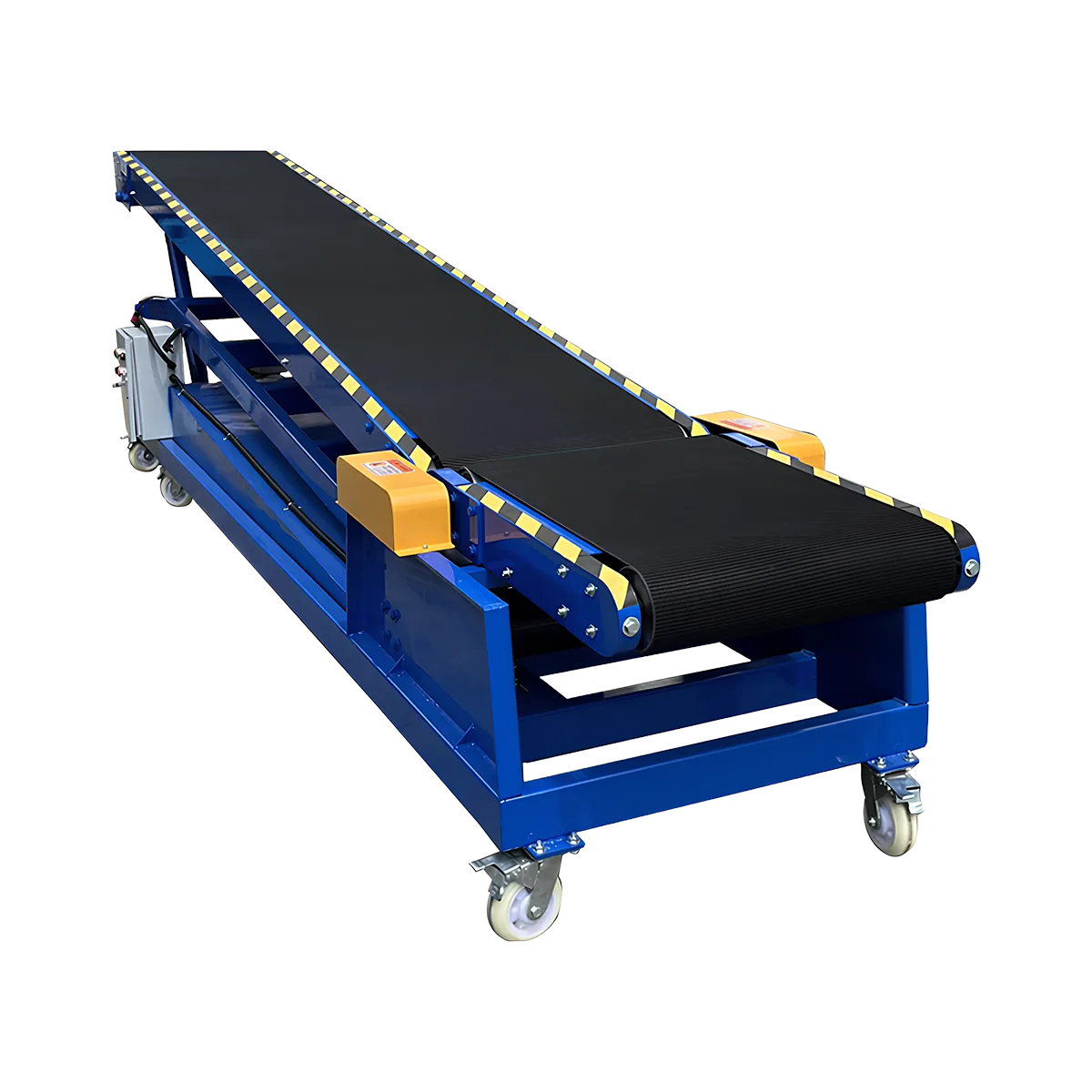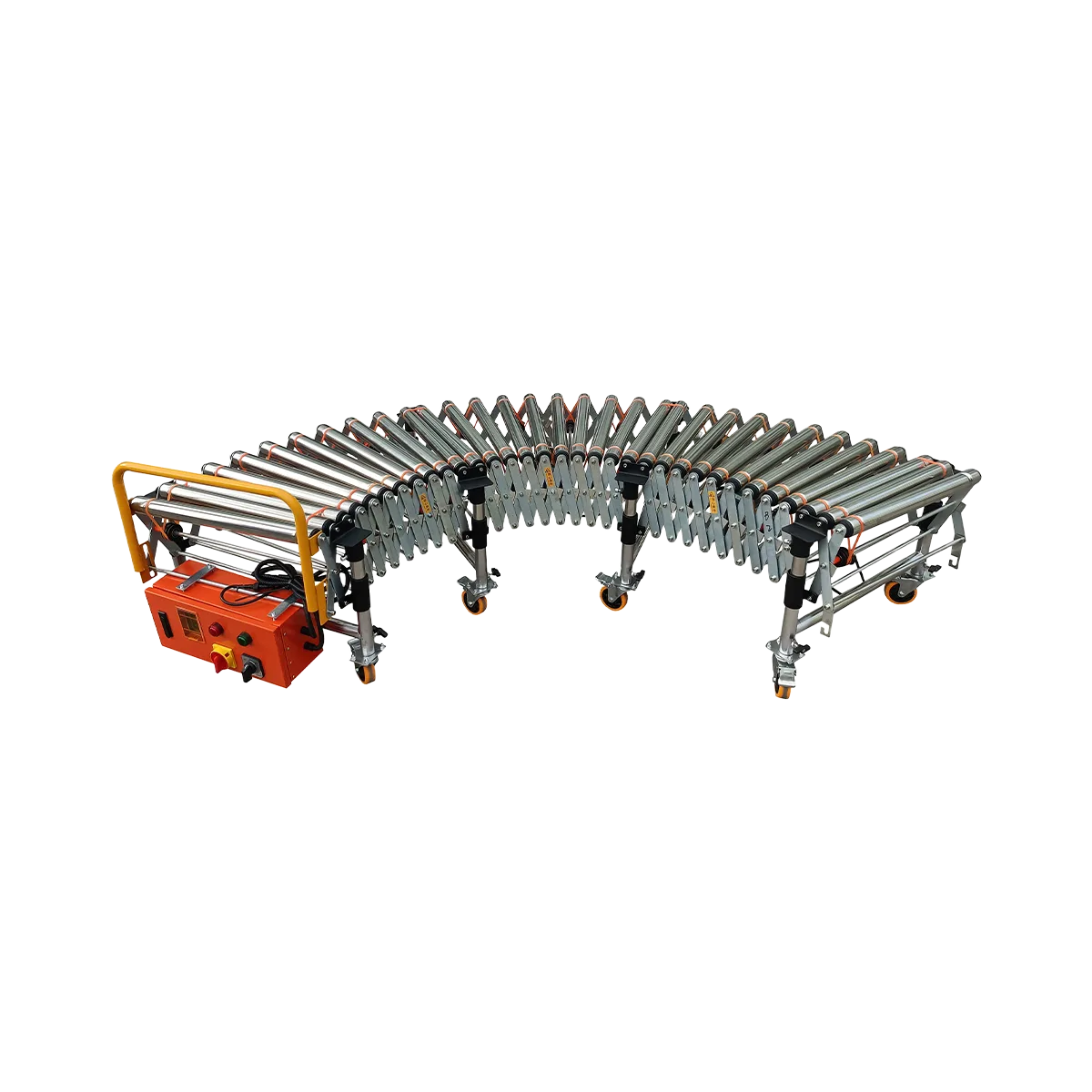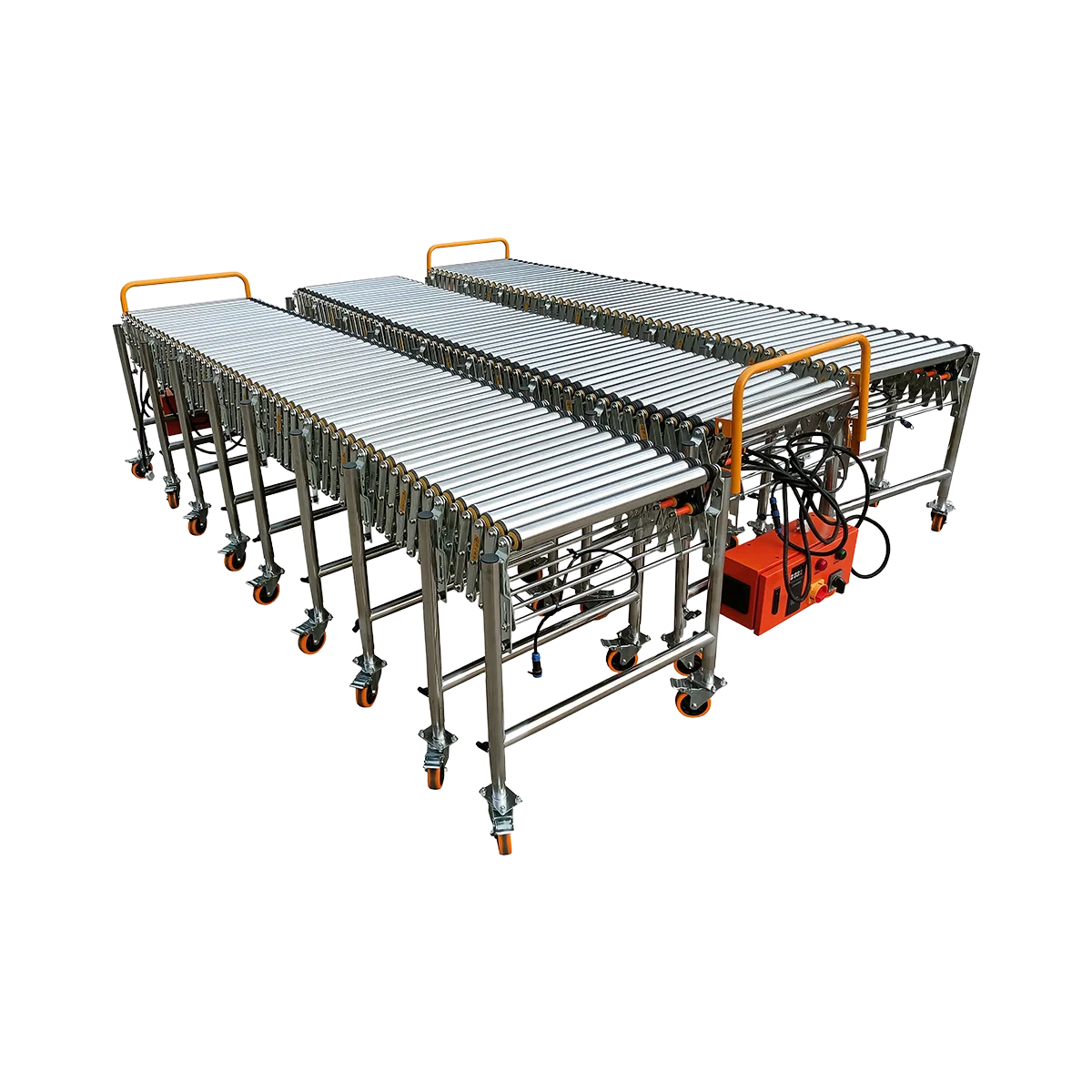How to Bridge the Gap Between Your Warehouse and a Truck on the Tarmac
Discover effective outdoor conveyor solutions for connecting warehouse to truck across open yards. Our guide to all-weather yard logistics will transform your loading efficiency.
Related Products
-
Hydraulic Conveyor – Large – 7900 mm LengthCollapsed LengthExtended LengthLoad Capacity
80 kg/m
Applicable GoodsFlat-bottomed Goods
Bagged Goods
-
Hydraulic Conveyor – Medium – 7000 mm LengthCollapsed LengthExtended LengthLoad Capacity
80 kg/m
Applicable GoodsFlat-bottomed Goods
Bagged Goods
-
Powered Roller Conveyor – O-shaped Belt Driven – 1500 mm/SectionCollapsed Length
525 mm
Extended Length1500 mm
Load Capacity80 kg/m
Applicable GoodsFlat-bottomed Goods
-
Powered Roller Conveyor – Multi-wedge Belt Driven – 2000 mm/SectionCollapsed Length
700 mm
Extended Length2000 mm
Load Capacity100 kg/m
Applicable GoodsFlat-bottomed Goods
-
Powered Roller Conveyor – Multi-wedge Belt Driven – 3000 mm/SectionCollapsed Length
1050 mm
Extended Length3000 mm
Load Capacity80 kg/m
Applicable GoodsFlat-bottomed Goods
When it comes to efficient warehouse operations, one of the most challenging scenarios is bridging the physical gap between your facility and vehicles parked on the tarmac. This common outdoor conveyor challenge occurs in facilities with limited dock space, older buildings without proper loading bays, or operations that have expanded beyond their original infrastructure. The distance—often 20 feet or more of open yard—creates a logistical hurdle that can significantly impact productivity, safety, and operational flow.
Traditional solutions like manual carrying or forklift shuttling create inefficiencies, safety risks, and bottlenecks in your yard logistics process. The ideal solution requires a system that can effectively span this distance while accommodating the height differential between ground level and truck beds, all while maintaining a continuous flow of goods. This article explores how to implement a comprehensive connecting warehouse to truck system using Naili’s modular conveyor solutions, creating an efficient bridge across your yard that transforms what was once a liability into a streamlined part of your operation.
The Challenge: How to create a safe, reliable bridge for your goods?
Creating an effective conveyor bridge between warehouse and truck presents several unique challenges that must be addressed for a successful implementation:
Distance and Terrain Considerations
The open yard between warehouse and truck typically presents several obstacles:
- Variable distances: The gap may range from 15 to 50+ feet depending on yard configuration
- Uneven surfaces: Tarmac, concrete, or gravel surfaces may have slopes, cracks, or irregularities
- Weather exposure: The system must function in various environmental conditions
- Traffic patterns: The solution must accommodate other yard vehicles and pedestrian movement
Height Differential Management
One of the most significant challenges is addressing the height difference between:
- Warehouse floor height (typically at ground level or slightly elevated)
- Truck bed height (typically 1200-1500mm from ground level)
- Any intermediate height changes across the yard
This requires a system that can not only span the horizontal distance but also create an appropriate incline to reach the truck bed height safely and efficiently.
Power Supply and Infrastructure
Implementing an all-weather conveyor system outdoors introduces additional considerations:
- Electrical requirements: Power must be available across the entire span
- Safety concerns: Outdoor electrical systems must be properly protected
- Mobility needs: The system should be repositionable to accommodate different trucks
- Setup efficiency: The solution should be quick to deploy and adjust
Operational Requirements
The ideal system must also meet several operational criteria:
- Sufficient capacity: Ability to handle your package volume and weight
- Appropriate speed: Fast enough for efficiency but safe for operation
- Durability: Robust construction to withstand regular use
- Adaptability: Flexible enough to work with different truck types and positions
Addressing these challenges requires a thoughtful combination of equipment specifically designed to create a seamless bridge between indoor and outdoor environments.
The Naili ‘Bridge’ System: A modular solution for yard gaps
After extensive research and field testing, Naili has developed a modular system that effectively bridges the warehouse-to-truck gap using complementary components that work together to create a seamless material flow.
A Hydraulic Conveyor at the truck end to manage the height
The foundation of the Naili bridge system is the hydraulic conveyor, which serves as the critical transition point between ground level and the truck bed:
- Adjustable height range: The hydraulic system provides precise height adjustment to match various truck bed heights (700mm to 2400mm depending on model)
- Powered belt surface: The 5.0mm PVC black grass-pattern anti-slip belt provides reliable grip for packages of all types
- Stable positioning: Heavy-duty casters with brakes ensure the unit remains secure during operation
- Bidirectional capability: Supports both loading and unloading operations with forward/reverse controls
- Weather-resistant construction: Robust steel frame construction withstands outdoor use
The hydraulic unit is positioned at the truck end of the system, with its height adjusted to create a smooth transition into the vehicle. The Small or Medium hydraulic conveyor models are typically ideal for this application, offering the right balance of size, capacity, and height adjustment range.
A series of Powered Roller Conveyor sections to span the distance
To bridge the horizontal gap between warehouse and hydraulic unit, a series of powered roller conveyor sections create a continuous powered path:
- Modular design: Multiple sections connect to form a customized length spanning the exact distance needed
- Self-powered operation: Each section includes its own drive system, eliminating the need for manual pushing
- Adjustable speed: Variable frequency drives allow speed adjustment from 0.3-40 m/min to match your throughput requirements
- Robust construction: Steel frame and zinc-plated rollers provide durability for outdoor use
- Height adjustability: Support legs adjust to create the optimal incline across the span
- Quick connection system: Sections link together with simple hook connectors for fast setup and reconfiguration
The multi-wedge belt driven 3000mm sections are particularly effective for this application, as they provide the longest span per section (reducing the number of connections needed) while maintaining excellent load capacity (80 kg/m).
Integration and Control
The complete system functions as a unified conveyor bridge through:
- Synchronized operation: A single control panel can manage the entire line
- Smooth transitions: Carefully aligned connection points ensure packages move smoothly between sections
- Consistent power: Properly configured electrical supply ensures reliable operation across the entire span
- Safety features: Emergency stop functionality across the entire system
This integrated approach creates a continuous powered path that efficiently moves packages across the yard gap while accommodating the height differential between warehouse and truck.
Important Considerations for Outdoor Use: Weather, power, and durability
While the Naili bridge system is designed with outdoor use in mind, several important considerations will ensure optimal performance and longevity when implementing your yard logistics solution.
Ensuring proper power supply to the conveyor sections
Providing reliable power across the outdoor span requires careful planning:
- Power requirements: A typical setup with multiple powered sections and a hydraulic unit requires a robust power supply, typically 380V three-phase power
- Cable management: Outdoor-rated cables should be properly secured and protected from vehicle traffic
- Connection points: Weatherproof electrical connections are essential for safety and reliability
- Circuit protection: Appropriate circuit breakers and ground fault protection for outdoor electrical systems
- Extension options: Consider industrial-grade extension cables with appropriate weather protection if fixed wiring isn’t practical
For maximum flexibility, some operations opt for portable generators specifically designated for the conveyor system, allowing deployment anywhere in the yard without fixed power infrastructure.
The robust nature of Naili’s steel frames for durability
Naili’s equipment is built with outdoor use in mind, featuring:
- Corrosion-resistant materials: Standard zinc-plated components resist rust and corrosion
- Stainless steel options: For particularly challenging environments, 201 stainless steel components are available
- Robust construction: Frame materials (Q345 steel with ≥3.5mm thickness) provide excellent durability
- Quality bearings: Sealed bearings protect against dust and moisture intrusion
- Industrial-grade motors: Protected motor housings designed for variable conditions
- Heavy-duty casters: Industrial casters with brakes ensure stability on outdoor surfaces
These construction features ensure the system can withstand the rigors of outdoor use while maintaining reliable performance over its 5-10 year expected lifespan.
Using in good weather conditions is advised for standard models
While the system is built to be durable, there are important weather-related considerations:
- Optimal conditions: The standard system performs best in dry conditions with temperatures between 0-40°C
- Rain protection: During light rain, temporary canopies can protect the system for short-term operation
- Wind considerations: In high wind conditions, ensure the system is properly secured
- Temperature extremes: In very hot or cold environments, motor duty cycles may need adjustment
- Storage recommendations: When not in use for extended periods, the system should be stored indoors or under cover
For operations requiring all-weather functionality, consider:
- Custom weather protection accessories
- Specialized motor and electrical protection
- Regular maintenance inspections after exposure to harsh conditions
Maintenance Considerations for Outdoor Systems
Outdoor deployment requires a slightly modified maintenance approach:
- Inspection frequency: Check systems more frequently than indoor equivalents
- Cleaning requirements: Remove dust, debris, and moisture regularly
- Lubrication: Apply appropriate weather-resistant lubricants to moving parts
- Electrical checks: Regularly inspect all electrical components for weather-related wear
- Roller condition: Monitor rollers for signs of corrosion or damage
With proper care and attention to these considerations, the Naili bridge system can provide reliable service even in challenging outdoor environments.
Why this is better than a forklift: Continuous flow vs. batch movement
When evaluating solutions for bridging warehouse-to-truck gaps across a yard, many operations default to using forklifts or pallet jacks. However, the conveyor bridge approach offers several significant advantages:
Continuous Flow of Goods
Unlike the batch-oriented approach of forklifts, the conveyor bridge creates a continuous flow of materials:
- Steady throughput: Packages move continuously rather than waiting for forklift return trips
- Consistent pacing: Creates predictable timing for loading/unloading operations
- Reduced bottlenecks: Eliminates waiting periods between forklift loads
- Higher capacity: Typical systems handle 2000-3500 packages per hour vs. 300-500 for a single forklift
- Balanced workload: Workers at each end can maintain consistent productivity
This continuous flow dramatically increases overall efficiency, particularly for operations handling individual packages rather than full pallets.
Safety Improvements
The conveyor bridge significantly reduces common safety risks:
- Reduced traffic: Eliminates forklift traffic between warehouse and truck
- Pedestrian separation: Creates a dedicated path for goods, separate from walking areas
- Injury prevention: Eliminates manual lifting between points
- Visibility: Clearly defined material path improves yard safety
- Accident reduction: Removes the risks associated with forklift operations in variable outdoor conditions
For many facilities, these safety benefits alone justify the investment in a conveyor bridge system.
Operational Advantages
Beyond throughput and safety, the system offers several operational benefits:
- Labor efficiency: Typically requires just 2 workers vs. multiple forklift operators
- Skill requirements: Minimal training compared to forklift certification
- Fuel savings: No fuel or battery charging costs associated with forklifts
- Space utilization: Fixed path requires less maneuvering space than forklift operations
- Maintenance comparison: Generally lower maintenance costs than forklift fleet
- Noise reduction: Significantly quieter than forklift operations
Cost Comparison
When analyzing the total cost of ownership:
| Factor | Forklift Solution | Naili Conveyor Bridge |
|---|---|---|
| Initial Investment | $25,000-35,000 per forklift | $15,000-25,000 for complete system |
| Operational Cost | $15-25 per hour (fuel/power, maintenance) | $3-5 per hour (electricity only) |
| Labor Cost | $20-30 per hour per operator | Same labor cost but higher throughput |
| Maintenance | Regular scheduled maintenance, repairs | Minimal maintenance, few moving parts |
| Lifespan | 5-7 years with high usage | 5-10 years with proper care |
| Throughput | 300-500 packages per hour | 2000-3500 packages per hour |
For operations handling more than 1000 packages daily, the conveyor bridge typically delivers ROI within 6-12 months through labor savings and efficiency improvements.
Implementation Guide: Setting up your yard bridge
Implementing a warehouse-to-truck conveyor bridge requires careful planning and execution. Here’s a practical guide to setting up your system:
Site Assessment and Measurement
Begin with a thorough evaluation of your specific requirements:
- Distance measurement: Precisely measure the gap between warehouse exit and typical truck position
- Height evaluation: Determine the height difference between warehouse floor and average truck bed
- Surface assessment: Evaluate the yard surface for evenness, slope, and stability
- Power availability: Identify power sources and determine if additional electrical work is needed
- Traffic patterns: Map existing vehicle and pedestrian routes to ensure minimal disruption
System Configuration
Based on your measurements, configure the appropriate components:
- Hydraulic conveyor selection: Choose the appropriate model based on required height range and capacity
- Small model (4000mm) for standard trucks up to 7.2m deep
- Medium model (7000mm) for larger trucks and containers
- Powered roller section calculation: Determine the number and length of sections needed
- Example: For a 30-foot gap, consider 3 sections of 3000mm powered roller conveyor
- Include slight overlap at connection points for smooth transitions
- Power requirements: Calculate total power needs based on all components
- Typical setup: 2.2kW for hydraulic unit + 0.75-2.2kW for powered sections
Installation Process
Follow these steps for efficient setup:
- Preparation:
- Clear and level the pathway between warehouse and truck position
- Ensure adequate power supply with appropriate protection
- Assemble all components and verify proper operation individually
- Positioning:
- Place the hydraulic conveyor at the truck end, allowing room for height adjustment
- Position powered roller sections to create a straight line from warehouse to hydraulic unit
- Ensure all units have brakes engaged once positioned
- Connection:
- Link sections using the hook connector system
- Adjust support legs to create a smooth, continuous path
- Connect power to each section according to manufacturer guidelines
- Test each connection point with a sample package
- Testing and Adjustment:
- Run the system without load to verify alignment and operation
- Test with various package sizes and weights
- Make fine adjustments to height, speed, and alignment as needed
Training and Operation
Ensure your team is properly prepared:
- Operator training: Train key personnel on system operation and adjustment
- Safety procedures: Establish clear safety protocols for operation and emergency situations
- Daily setup routine: Create a checklist for daily deployment and retraction
- Weather response plan: Develop procedures for unexpected weather changes
With proper planning and implementation, your yard bridge can be operational within 1-2 days, immediately improving your loading and unloading efficiency.
Conclusion: Extend your warehouse workflow right to the truck door, no matter the distance
Bridging the gap between warehouse and truck no longer requires accepting the inefficiencies and safety risks of manual handling or forklift shuttling. By implementing a modular conveyor system that combines hydraulic height adjustment with powered roller sections, you can create a seamless extension of your warehouse workflow that reaches directly to the truck door, regardless of the distance across your yard.
This loading across a yard solution transforms what was once a logistical challenge into a streamlined process that increases throughput, improves safety, and reduces labor requirements. The modular nature of the Naili system means it can be precisely tailored to your specific yard configuration, truck types, and package characteristics, creating a custom solution without custom pricing.
For operations dealing with the daily challenge of loading and unloading trucks parked on the tarmac away from the building, this approach represents one of the most impactful efficiency improvements available. By eliminating the “yard gap” as a bottleneck, you enable your entire operation to function at its optimal capacity, turning a physical limitation into a competitive advantage.
Whether you’re dealing with a temporary yard arrangement or a permanent infrastructure challenge, the loading and unloading bridge system provides a practical, cost-effective solution that pays for itself through improved operational efficiency and reduced labor costs.
Frequently Asked Questions
How long does it take to set up and break down this system each day?
With trained staff, the system typically requires 15-20 minutes for setup and 10-15 minutes for breakdown. This includes positioning the components, connecting sections, adjusting heights, and testing operation. Most customers develop efficient routines that minimize this time further after several weeks of operation.
Can this system work in rainy or snowy conditions?
The standard system is designed for use in good weather conditions. While brief operation during light rain is possible, extended exposure to heavy rain or snow is not recommended for standard models. For operations requiring all-weather functionality, custom weather protection solutions can be developed, or the system can be deployed under temporary canopies.
What is the maximum distance this system can span?
There is no strict technical limit to the total distance. By connecting multiple powered roller conveyor sections, the system can theoretically span any reasonable distance. Practical implementations typically range from 20 to 100 feet. For very long spans, additional consideration must be given to power distribution and system alignment.
How does the system handle different truck heights?
The hydraulic conveyor component is specifically designed to address height variations. With adjustment ranges from 700mm to 2400mm (depending on model), it can accommodate everything from small delivery vans to full-height shipping containers. The hydraulic system allows precise height matching with the truck bed for smooth transitions.
What maintenance is required for outdoor use?
Outdoor systems require slightly more frequent maintenance than indoor equivalents. This includes regular inspection of electrical components, cleaning of rollers and belts to remove debris, lubrication of moving parts with weather-appropriate lubricants, and checking connection points for security. After exposure to harsh weather, additional inspection is recommended. With proper care, the system maintains its 5-10 year operational lifespan even in outdoor applications.
Table of Contents
Recent Posts
Discover how to select the perfect conveyor width for your warehouse operations. Our expert guide helps you match box sizes to conveyor dimensions for optimal efficiency and fewer jams.
Discover the ideal van loading conveyor solution for Sprinter, Transit and other delivery vehicles. Our Micro Hydraulic Conveyor system boosts efficiency while saving labor costs.





